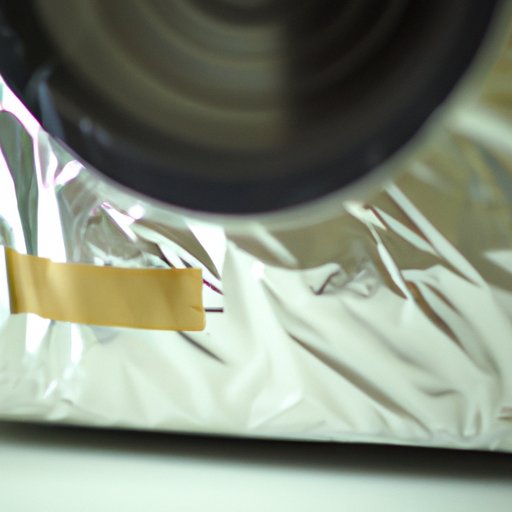
Introduction
Microwaves have become a staple kitchen appliance, providing quick and easy heating of food. However, it is important to understand the safety considerations when using a microwave. One common question that people ask is, can you put tinfoil in a microwave? In this article, we will explore the dangers of using tinfoil in a microwave and provide tips for safe microwave use.
5 Reasons Why Putting Tinfoil in a Microwave is Dangerous
There are several reasons why putting tinfoil in a microwave is dangerous. Here are five of the most important:
- Fire hazard: Tinfoil can cause sparks and fire in a microwave.
- Arcing: The metal in tinfoil causes an arc of electricity to form between the foil and the metal walls of the microwave.
- Damage to the microwave: The arcing caused by tinfoil can damage the microwave and in extreme cases, render it unusable.
- Food quality: Tinfoil can cause uneven cooking and heating of food, creating hot spots that can burn or scorch the food.
- Health hazards: While there is no conclusive evidence, it is possible that tinfoil may release harmful chemicals when heated in a microwave.
It is important to understand the safety hazards caused by putting tinfoil in the microwave and avoid any potential risks.
Microwave Tips: What Items Should Never Be Put in the Microwave
Aside from tinfoil, there are several other items that should never be put in a microwave. These items include:
- Metal utensils or containers: These items can cause arcing similar to what happens with tinfoil.
- Plastic containers that are not microwave-safe: These containers can melt and release harmful chemicals into the food.
- Brown paper bags: These can ignite and cause a fire due to the high temperatures inside the microwave.
- Styrofoam or foam containers: These containers can melt and release harmful chemicals into the food.
- Eggs in their shell: The steam buildup inside the shell can cause the egg to explode in the microwave.
It is important to follow the guidelines for safe microwave use and avoid putting these items in the microwave to prevent potential hazards.
The Science Behind Why Tinfoil Causes Fires in Microwaves
Before we can understand why tinfoil causes fires in microwaves, we must first understand how microwave ovens work. Microwaves use electromagnetic radiation to heat food. Waves of energy pass through the food and excite the water molecules, causing them to vibrate and generate heat. The heated water molecules then cook the food.
Tinfoil interacts with microwaves by acting as an antenna, reflecting and concentrating the waves onto itself. This creates a high electric charge in the foil, causing it to spark and ignite. The metal in tinfoil also forms an arc of electricity between the foil and the metal walls of the microwave, creating a fire hazard. This is why it is important to never put tinfoil in the microwave.
Alternatives to Using Tinfoil in the Microwave
If you need to cover your food in the microwave, there are several alternatives to using tinfoil. These include:
- Microwave-safe lids: These plastic or glass lids are specifically designed for microwave use and can cover food while allowing steam to escape.
- Paper towels: These can be placed over food to prevent splatters and allow the steam to escape.
- Microwave-safe wax paper: This can be used to wrap food or cover dishes in the microwave.
- Microwave-safe plastic wrap: This can be used to cover food in the microwave, but make sure to vent it to allow steam to escape.
Each of these alternatives has its own advantages and disadvantages, so be sure to follow specific guidelines for each product to ensure safe microwave use.
The Dos and Don’ts of Safely Using a Microwave
Here are some best practices for using a microwave safely:
- Use microwave-safe containers and utensils.
- Don’t overcrowd the microwave – leave enough space for the food to rotate and heat evenly.
- Stir or rotate food during cooking to ensure even heating.
- Follow cooking times and microwave wattage settings, and never leave food unattended while cooking.
- Check the temperature of the food before eating to prevent burns from hot spots.
It is also important to avoid common mistakes that can cause hazards, such as forgetting to remove the metal twist-ties from bags or containers before microwaving.
Microwave Safety Myths Debunked: Why Tinfoil Doesn’t Belong in the Microwave
There are several misconceptions about microwave safety, including the belief that it is safe to put tinfoil in the microwave. However, as we’ve discussed, tinfoil can cause sparks, fires, and even health hazards when used in a microwave. It is important to follow the guidelines for safe microwave use and avoid putting items like tinfoil in the microwave.
Conclusion
In conclusion, it is crucial to understand the importance of microwave safety. While using a microwave is a convenient way to heat food, it is important to follow guidelines for safe use and avoid putting items like tinfoil in the microwave. By understanding the dangers associated with using tinfoil in the microwave and following our tips for safe microwave use, you can ensure that your microwave remains a safe and convenient appliance in your kitchen.





